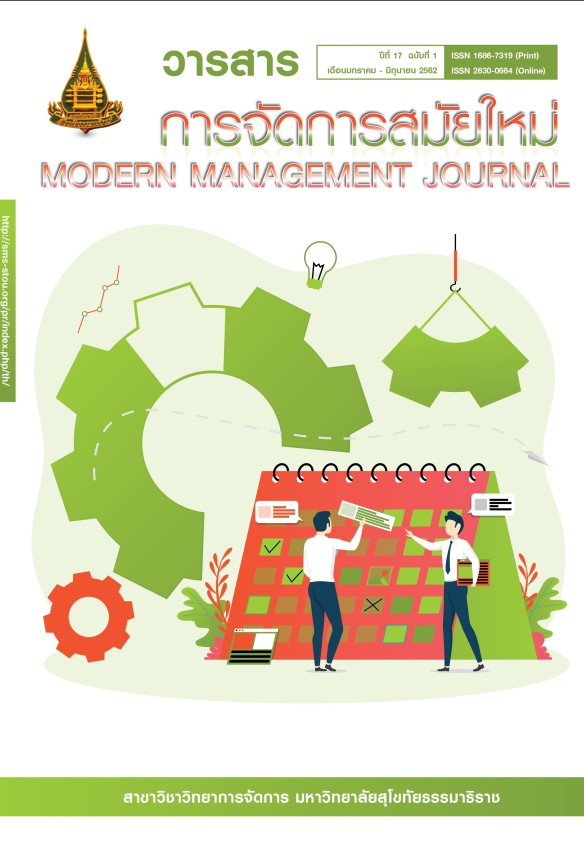STRATEGY FOCUSED ORGANIZATION OF THE MINISTRY OF FINANCE
Keywords:
Strategy Focused Organization, The Ministry of FinanceAbstract
The purposes of this research were to (1) investigate the level of being the strategy focused organization of the Ministry of Finance, (2) study the factors influencing the development to strategy focused organization of the Ministry of Finance, (3) recommend for the management of the Ministry of Finance towards strategy-focused organization.
This study was a survey research by using cross-sectional study, focused on quantitative and qualitative. Population was the Ministry of Finance (MOF) which comprised 9 departments, having 240 personnel representative of the division of policy and planning, and including 1 senior executives of the MOF. The sample groups were 150 officers of the division of policy and planning calculated by Yamane.
Instruments used were: (1) questionnaire for collecting both quantitative and qualitative data from 150 officers obtained via proportional stratified random sampling; (2) interview form for collecting qualitative data from in-depth interview of 1 senior executives derived from purposive sampling. Statistics data were analyzed using percentage, mean, and standard deviation, t-test, and stepwise regression analysis. Qualitative data were analyzed using the content analysis.
The results revealed that (1) the average of level of being the strategy focused organization of the Ministry of Finance for achieving the strategic plan was 4.34, and found hypothesis testing of the level of being the strategy focused organization was not less than 80% at the level of significant 0.05 . (2) Mobilize change through executive leadership, translate the strategy to operational terms, and align the organization to the strategy were factors positively influenced the development to strategy focused organization of the Ministry of Finance at 83.7 % at the level of significant 0.05 by multiple regression analysis. (3) Recommendation as the followings: the top management of MOF will having highly organization engagement and proactive to reach the vision and the target of MOF; formulate the clearly roadmap plan to change the MOF, and always adjust the challenge of vison and strategy of MOF.
References
Boonyarataphan,Th. (2011). Strategic Formulation Plan of the Energy Policy and Planning Office, Ministry of Energy. Bangkok : Research Project.
Boonyarataphan,Th. (2013). Balanced Scorecard System Development of SeAH Precision Metal (Thailand) Co., Ltd. Bangkok : Research Project.
David, F. R. (1993). Strategic Management. New York : Macmillan Publishing Company.
David, F. R.(2013). Strategic Management Concepts and Cases : A Competitive Advantage Approach. Boston : Pearson.
Hitt, M. A., Ireland, R. D., & Hoskisson, R. E. (2015). Strategic Management : Competitiveness and Globalization : Concepts and Cases. Singapore : Cengage Learning Asia Pte Ltd.
Hoque, Z. (2014). 20 Years of Studies on the Balanced Scorecard: Trends, Accomplishments, Gaps, and Opportunities for Future Research, The British Accounting Review. 46. 33-59.
Jiang, D., & Liu, Z. (2014). Applicatiom of Balanced Scorecard in the GovernmentPerformance Appraisal, Open Journal of Social Sciences. 2 , 91-96.
Kaplan, R. S., & Klein, N. (1995). Chemical Bank: Implementing the Balanced Scorecard. Harvard Business School Press.
Kaplan, R. S., & Norton, D. P. (1992). The Balanced Scorecard: measures that drive performance, Harvard Business Review. Jan – Feb, 71–80.
Kaplan, R. S., & Norton, D. P. (1993). Putting the Balanced Scorecard to Work, Harvard Business Review. Sep – Oct, 2–16.
Kaplan, R. S., & Norton, D. P. (1996). Using the Balanced Scorecard as a strategic management system, Harvard Business Review. Jan – Feb, 75–85.
Kaplan, R. S., & Norton, D. P. (1996). Balanced Scorecard: Translating Strategy into Action. Harvard Business School Press.
Kaplan, R. S., & Norton, D. P. (2001). The Strategy-Focused Organization. Boston : Harvard Business School Press.
Kaplan, R. S., & Norton, D. P. (2004). Measuring the Strategic Readiness of Intangible Assets. Harvard Business Review, 82(2), 52-63.
Kaplan, R. S., & Norton, D. P. (2004). Strategy Maps. Massachusetts : Harvard Business School Press.
MacIntosh, R., & Maclean, D. (2015). Strategic Management : Strategists at Work. London : Palgrave.
Madsen, D. O., & Stenheim, T. (2015). The Balanced Scorecard : A Review of Five /Mike W. Peng.
Parnell, J. A. (2014). Strategic Management : Theory and Practice. California : SAGE Publications.
Pearce II, J. A., & Robinson, R. B. (2013). Strategic Management : Planning for Domestic & Global Competition. 14th ed. New York : McGraw-Hill Education.
Peng, M. W. Global Strategic Management (2014). Australia : South-Western Cengage Learning.
Pitt, M., & Koufopoulos, D. (2012). Essentials of Strategic Management. Los Angeles : SAGE Publication.
Prateep,C., Boonyarataphan,Th ., Udomwisawakul, N., & Smitananda, P. (2014). Review the Strategic Plan of Fuel Fund (2012-2016). Bangkok : Research Project.
Saloner, G., Shepard, A., & Padolny, J. (2001). Strategic Management. New York : John Wiley & Sons, Inc.
Schilling, M. A. (2013). Strategic Management of Technological Innovation. New York : McGraw-Hill.
Steiss, A. W. (2003). Strategic Management for Public and Nonprofit Organizations. New York : Marcel Dekker,Inc.
Reorganization of Ministry, Sub-Ministry, and Department Act, B.E. 2545
Wheelen T. L., Hunger J. D., Hoffman A. N., & Bamford C. E. (2015). Strategic Management and Business Policy : Globalization, Innovation, and Sustainability. Harlow : Pearson Education Limited.



